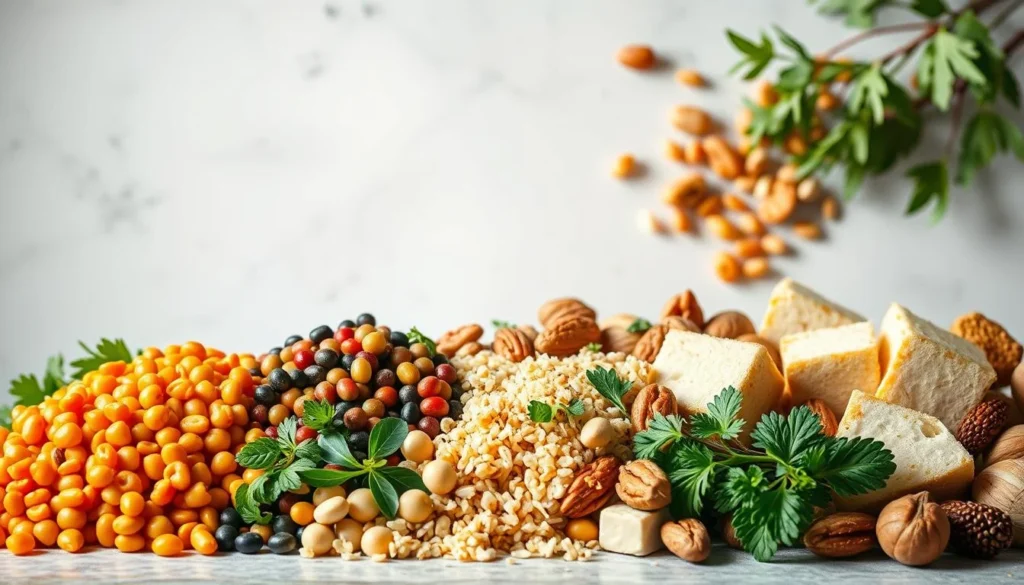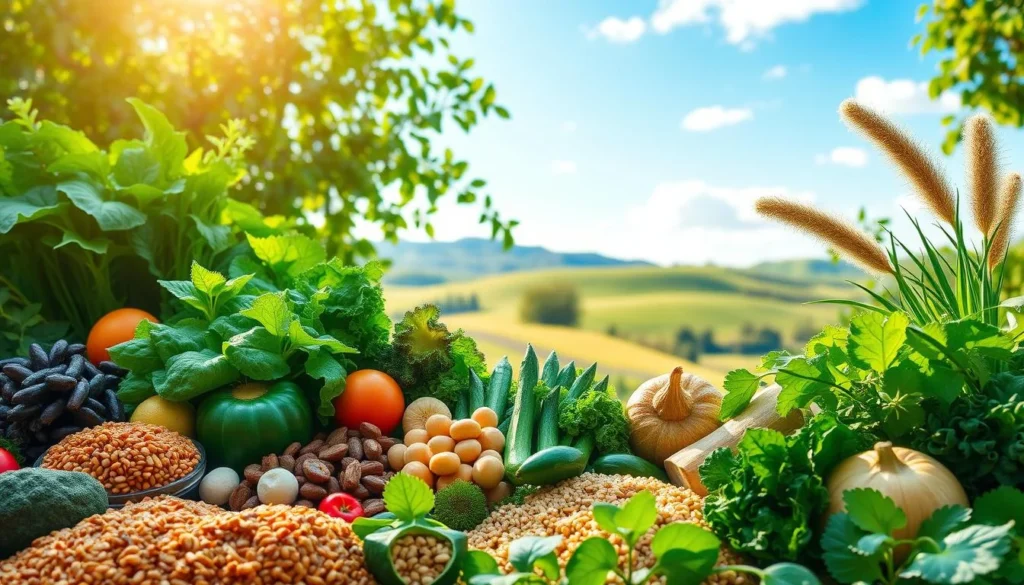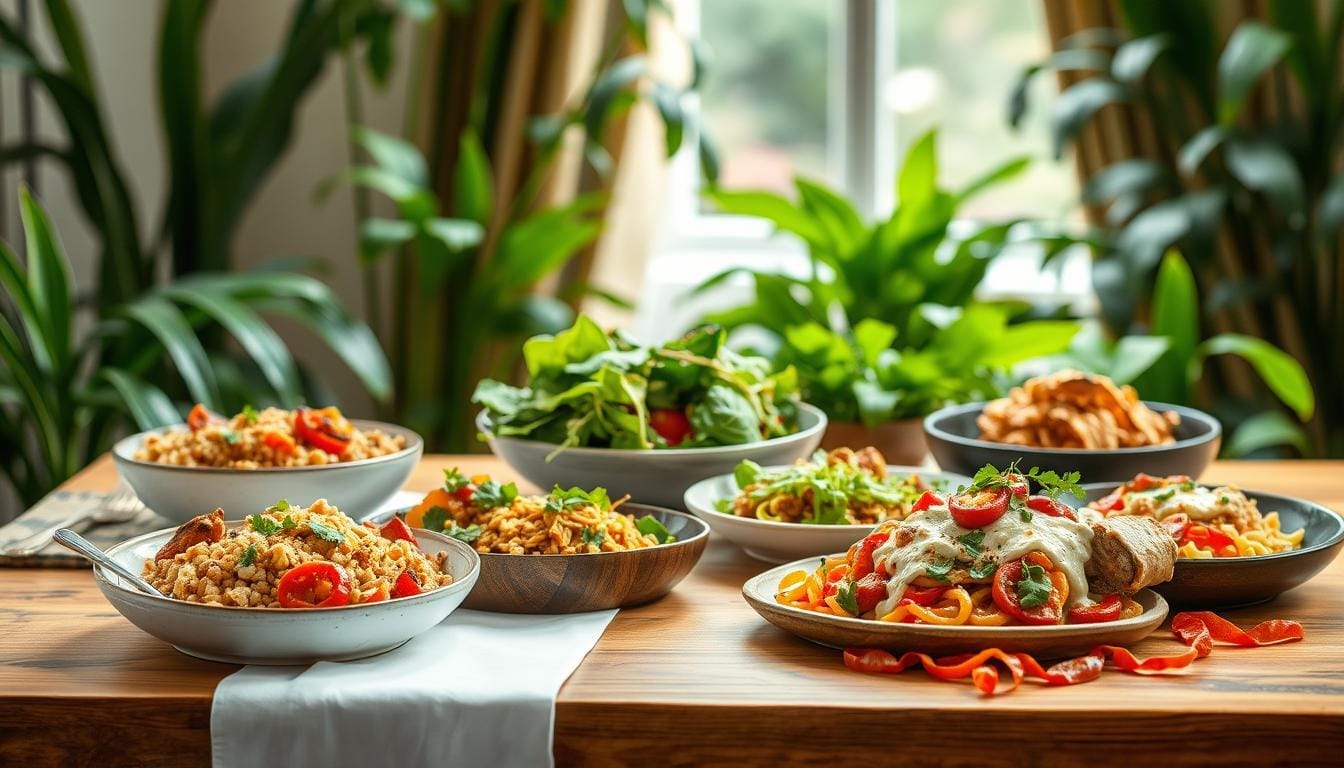Plant-Based Meals: Enjoy a Happier, Healthier Lifestyle
Every morning, we make choices that affect how we feel and live. Millions in the U.S. are choosing plant-based meals like grain bowls and lentil soups. These choices boost our energy and connect us with the world.
Starting with plant-based eating is easy. Try oat milk lattes, black bean tacos, or roasted vegetable platters. These foods are good for your health and the planet. They make you feel empowered to cook delicious meals that fit your life.
Table of Contents
Understanding the Plant-Based Lifestyle
Choosing a plant-based lifestyle means eating more foods from plants and less from animals. It focuses on fruits, veggies, grains, and legumes for better health. Unlike strict diets, it lets you enjoy dairy or eggs sometimes.
Delicious and Simple Plant-Based Recipes
Exploring a plant-based diet opens up a world of flavor and creativity for the home cook. You can find incredible recipe collections online dedicated to quick & easy vegan meals that make weekday dinners a breeze. Imagine whipping up a creamy butternut squash curry or a comforting One-Pot Chickpeas and Sweet Potato Curry on a busy Tuesday. For something lighter, a hearty Vegan “Chicken” Noodle Soup or a vibrant vegan broccoli soup can be incredibly satisfying. These dishes rely on the power of whole foods to deliver amazing taste. Simple vegetable sides can be elevated with an air fryer, like Herbed Air Fryer Sweet Potato Cubes, which get perfectly crispy with minimal effort. Even classic comfort foods get a makeover; think plant-based pasta with a rich tomato sauce or a savory Vegan Pastelón, a Puerto Rican dish traditionally made with meat. Starting with a few reliable plant-based recipes is the perfect way to build confidence in the kitchen.
What Defines a Plant-Based Diet
A plant-based diet is all about whole foods like beans, nuts, and greens. These plant based meals are full of nutrients and less processed. Think of a quinoa salad or a lentil curry as a complete meal. It’s flexible, fitting into many lifestyles.
Plant-Based vs. Vegan: Key Differences
- Veganism: Avoids all animal products, even leather and cosmetics. It’s often for ethical and environmental reasons.
- Plant-Based: Focuses on diet changes, encouraging vegetarian dishes but sometimes includes small amounts of meat or dairy. It’s about health.
Health Benefits Supported by Research
Studies by the American Heart Association show plant-based diets can lower heart disease risk by 16%. They also help with high blood pressure. Research in the Journal of the Academy of Nutrition and Dietetics finds these diets aid in weight management. They improve cholesterol and gut health with foods like chickpeas or spinach.
Essential Nutrients in Plant-Based Meals
Plant-based meals often raise questions about getting all the nutrients. A diet rich in whole foods can provide everything needed. Key nutrients like protein, iron, and calcium are found in abundance in plant-based foods, if chosen wisely.
- Protein: Lentils, chickpeas, and tofu are good sources of amino acids. Quinoa and amaranth are complete proteins.
- Iron: Spinach, fortified cereals, and pumpkin seeds are rich in iron. Eating foods high in vitamin C with them helps iron absorption.
- Calcium: Kale, almonds, and fortified plant milks are great for bone health.
- Zinc: Nuts, beans, and whole grains are good sources. Soaking legumes makes zinc easier to use by the body.
- Omega-3s: Flaxseeds and walnuts have ALA. For DHA/EPA, consider algae-based supplements.
Vitamin B12 is hard to find in plant foods. Look for fortified nutritional yeast or supplements. Vitamin D can be made from sunlight and is found in mushrooms that have been exposed to UV light. These steps help ensure you get all the nutrients without animal products. By choosing a variety of ingredients, you can make your meals very nutritious. Focus on whole foods like leafy greens, legumes, and whole grains. Plant-based eating is full of fiber, antioxidants, and phytonutrients, meeting today’s dietary needs.
Getting Started with Plant Based Meals: A Beginner’s Guide
Starting to eat more plant-based is easy with the right steps. Here’s how to set up your kitchen for plant-based meals. It makes cooking every day simpler.
Mastering Plant-Based Meal Prep
Adopting a plant-based diet is made much simpler with a solid meal prep strategy. Spending a few hours on the weekend can set you up for a week of delicious, healthy meals. You can prepare versatile components like whole grains, roasted vegetables on a baking sheet, and flavorful sauces. A turmeric tahini sauce or a zesty cashew lime cream can transform simple grain bowls into something special. Making a batch of Cinnamon Date Paste provides a natural sweetener for everything from oatmeal to desserts. Consider prepping ingredients for veggie burgers or baking a batch of Vegan Pumpkin Muffins or pumpkin baked oats for easy breakfasts. This approach helps you stay on track with your nutrition goals and makes choosing sustainable food options effortless. With a little planning, meal prep becomes an essential part of maintaining a whole-foods plant-based lifestyle.
Stocking Your Pantry with Plant-Based Essentials
First, gather the basics:
- Grains: Quinoa, oats, and brown rice
- Legumes: Lentils, chickpeas, and black beans
- Nuts/seeds: Almonds, chia seeds, and flaxseeds
- Plant-based proteins: Tofu, tempeh, and nutritional yeast
Choose sustainable foods like bulk grains and canned legumes. They help cut down on waste.
Kitchen Tools That Make Preparation Easier
| Tool | Purpose | Example |
|---|---|---|
| Pressure cooker | Cooks beans/grains faster | Stovetop or electric models |
| High-speed blender | Smoothies, soups, and nut milks | Vitamix or Blendtec |
| Mandoline slicers | Consistent veggie prep | Swissmar or OXO brands |
Meal Planning Strategies for Success
- Plan weekly menus around seasonal produce
- Batch-cook grains and legumes for quick meals
- Repurpose leftovers into new dishes (e.g., roasted veggies into frittatas)
- Explore vegan recipes from apps like Minimalist Baker or Oh She Glows
Essential Ingredients for a Plant-Based Kitchen
Stocking your pantry with the right ingredients is key to success on a plant-based diet. Nutritional yeast is a must-have for its cheesy, savory flavor, perfect for sprinkling over pasta or popcorn. A variety of seeds and nuts are excellent protein sources and add texture to salads and grain bowls. Having whole grains like quinoa, brown rice, and oats on hand provides a solid base for many meals. For sauces and dressings, a homemade vegan honey mustard sauce can liven up any dish. When it comes to baking, you can easily make treats like dairy-free herb biscuits. Exploring different ingredients, from cauliflower rice as a low-carb alternative to traditional rice, to using an air fryer for perfectly cooked vegetables, keeps meals exciting. Building a well-stocked pantry ensures you always have what you need to create delicious and nourishing Plant Based meals.
Transitioning Gradually
Start with small changes:
- Replace one meat meal weekly with lentil curry
- Swap cow’s milk for almond milk in morning routines
- Try meatless Monday challenges to build confidence
Pair these changes with sustainable food options. Use reusable containers to reduce waste.
Power-Packed Breakfast Ideas Without Animal Products
Start your day with plant-based meals that are quick and nutritious. These vegan recipes and cruelty-free cooking methods make it easy to begin your day with vibrant flavors and whole foods.
H3: Quick Morning Options Ready in 10 Minutes
Quick meals don’t mean they’re not good. Try:
- Overnight oats blended with plant milk, chia seeds, and frozen berries. Refrigerate and enjoy cold or warm.
- Tofu scramble seasoned with turmeric and garlic powder, paired with roasted veggies for a protein-packed start.
- Smoothie bowls topped with nuts, goji berries, and coconut flakes—perfect for on-the-go mornings.
H3: Make-Ahead Breakfast Solutions for Busy Weekdays
Prep ahead with:
- Chia pudding jars layered with mango slices and cacao nibs for a sweet, fiber-rich treat.
- Frozen breakfast burritos filled with black beans, spinach, and salsa—simply pan-sear for a 5-minute meal.
- No-bake energy balls made with dates, peanut butter, and rolled oats, stored in the fridge for instant snacks.
H3: Weekend Brunch Recipes to Impress Guests
Weekends are for indulgence. Impress with:
- Jackfruit “bacon” and avocado toast on sourdough, topped with a drizzle of tahini.
- Mushroom and leek frittata made with silken tofu, baked until set and sliced into wedges.
- Fluffy buckwheat pancakes dusted with cinnamon and maple syrup, served with roasted apple slices.
Each option uses natural ingredients like tempeh or nutritional yeast for extra flavor. Look for brands like Bob’s Red Mill for gluten-free oats or Just Egg for tofu alternatives. These meals show that plant-based eating is creative and satisfying.
Satisfying Lunch and Dinner Plant-Based Meals
Plant-based meals can be just as filling as traditional ones. Try hearty soups like lentil bolognese or chickpea curry. They’re packed with protein and taste great. Bean chili is another option, with tomatoes, spices, and kidney beans.
Build grain bowls for a satisfying meal. Mix quinoa, roasted veggies, and avocado. Stuffed bell peppers with rice, black beans, and salsa are also vibrant and nutritious. For quick meals, try vegetarian dishes like jackfruit tacos or Beyond Meat in pasta sauces.
| Recipe | Key Ingredients | Prep Method |
|---|---|---|
| Lentil Bolognese | Lentils, tomatoes, garlic, herbs | Sauté vegetables, simmer lentils in tomato sauce |
| Chickpea Curry | Chickpeas, coconut milk, curry powder, spinach | Simmer spices with chickpeas, add spinach at end |
| Jackfruit Tacos | Jackfruit, corn tortillas, lime, salsa | Season shredded jackfruit, warm in taco seasoning, serve in tortillas |
Use techniques like roasting to add flavor. Pair dishes with whole grains or legumes for protein. Try global cuisines like Japanese miso bowls or Indian dal. These tips make every meal satisfying and plant-focused.
Plant-Powered Protein Sources for Complete Nutrition
Many think plant-based diets lack protein, but plant based meals have many options. Legumes, nuts, and new products give all amino acids when mixed right. This helps meet healthy eating goals. Learn how to make full meals without animal products here.

Legumes: The Versatile Protein Powerhouses
Beans, lentils, and peas have 15-20g of protein per cup. Try:
- Black beans in tacos or soups
- Chickpeas roasted as snacks or blended into hummus
- Lentils in curries or salads
Pair with whole grains like rice or quinoa for all amino acids. Soak dried legumes overnight to cook faster and digest better.
The Bigger Picture: Sustainability and Nutrition
Making conscious food choices goes beyond personal health; it has a significant environmental impact. Shifting towards a more sustainable lifestyle often involves reducing meat consumption and embracing more plant-based meals. This change can lower your personal carbon footprint and reduce water use associated with food production. Exploring sustainable food options, like those offered at a macrobiotic restaurant or a forward-thinking establishment like Forage Kitchen, can provide inspiration. For those seeking guidance, a Registered Dietitian can offer evidence-based nutrition tips to ensure you are meeting all your nutritional needs. Many people have successfully adopted a plant-based diet, finding it a powerful way to align their eating habits with their values. This journey is supported by a growing community and abundant resources, making it easier than ever to make a positive change for both yourself and the planet.
Nuts and Seeds: Small but Mighty Nutritional Giants
Almonds, chia, and hemp seeds have 5-10g of protein per ounce. Sprinkle sunflower seeds on salads, grind flaxseeds into smoothies, or mix nut butters into oatmeal. For plant powered cuisine, try:
- Walnut crumbles as a meat substitute in salads
- chia pudding topped with berries for breakfast
Plant-Based Protein Products Worth Trying
Brands like Impossible Foods and Lightlife offer soy protein and tempeh. Tofu (10-20g protein per ½ cup) is great in stir-fries or scrambles. Choose products with simple ingredients and little additives. Pair with veggies for balanced meals.
Seitan, made from wheat gluten, has 21g protein per 3oz serving. Try marinades to add flavor. Always check labels for added sodium or sugars.
Creative Approaches to Meatless Meals That Satisfy Cravings
Turning cravings into plant based meals begins with new takes on old favorites. By mixing up familiar dishes with global tastes and strong flavors, you can make meatless meals just as satisfying as the originals.
Recreating Family Favorites with Plant Ingredients
Try using lentils or Beyond Meat® in place of ground beef in chili or tacos. Tofu or jackfruit can make great “pulled pork” in sandwiches. Seitan or textured soy protein works well for meatloaf. These swaps keep the comfort while adding health benefits.
Global Cuisines Naturally Rich in Plant-Based Options
- Indian: Dal, chana masala, and paneer curries use legumes and dairy alternatives
- Middle Eastern: Falafel, tabbouleh, and stuffed grape leaves packed with herbs
- Ethiopian: Injera flatbread paired with lentil wats and vegetable stews
- Latin: Black bean enchiladas, plantain empanadas, and jackfruit carnitas
Techniques for Building Flavor Without Animal Products
Discover umami with mushrooms, soy sauce, and sun-dried tomatoes. Roasting vegetables brings out their natural sweetness. Use:
- Smoked paprika and liquid aminos for savory depth
- Toast spices before cooking to enhance aroma
- Blend tahini or nutritional yeast for creamy sauces
These methods make vegan recipes that everyone will love, just as good as dishes with meat.
Eco-Friendly Aspects of Choosing Plant-Based Cuisine
Choosing plant powered cuisine is great for your health and the planet. Studies show that eating a few plant-based meals a week can greatly reduce your environmental impact. For example, it takes 1,800 gallons of water to produce a pound of beef, but only 43 gallons for a pound of lentils.

Animal agriculture is a big contributor to global greenhouse gas emissions, making up to 14.5% of them. On the other hand, sustainable food options like legumes and grains produce much fewer emissions. Here’s a comparison of environmental impacts:
| Category | Plant-Based | Animal-Based |
|---|---|---|
| Water Use | 10x less | Heavy reliance |
| Land Use | Requires 2x less land | Uses vast forests |
| Carbon Footprint | Lower emissions | Higher methane output |
Small changes can make a big difference. Here are ways to increase your eco-impact:
- Opt for sustainable food options like locally grown produce.
- Choose certified brands with eco-labels such as Fair Trade or Regenerative Organic.
- Reduce food waste by planning meals around seasonal ingredients.
Every bite of plant powered cuisine helps clean the air, save forests, and conserve water. Even small changes can lead to big environmental wins.
Addressing Common Challenges of Plant-Based Eating
Starting a plant-based diet can be tough, but there are easy ways to make it work. These tips help you stay on track with cruelty-free cooking and eco-friendly dining.
Navigating Restaurants with Confidence
Many restaurants now have plant-based options. Begin by looking up menus online or using apps like HappyCow. When you order, ask for substitutions like plant-based cheese or extra veggies.
For example, Thai curries or pasta dishes often work well. Always check if there’s a risk of cross-contamination in the kitchen.
- Search restaurant websites for labeled vegan options
- Request “meatless” versions of classics like tacos or stir-fries
- Choose spots with dedicated plant-based menus
Handling Social Gatherings Gracefully
Bring a dish to share at potlucks, like quinoa salads or roasted veggie trays. Explain your choices: “I’m exploring healthy eating to improve my energy levels.” Offer to help plan meals to fit your goals.
Family dinners can include dishes everyone likes, like stuffed peppers or grain bowls.
Making Nutrients Work for You
Pair foods for better nutrition: oatmeal with nuts and berries is a good mix. Beans with rice give you complete proteins. If you don’t get enough sunlight, consider B12 supplements.
Use apps like MyFitnessPal to track what you eat. Learn about iron-rich foods like lentils and spinach. Smoothies with greens and almond milk are great for snacks. Small changes can make a big difference.
Conclusion: Embracing the Plant-Based Journey for Long-Term Health
Plant-based meals are a great way to eat healthier and help the planet. Studies show they can make your heart stronger, give you more energy, and reduce harm to the environment. Even small changes, like eating legumes instead of meat once a week, can make a big difference.
Starting this journey doesn’t mean you have to be perfect. Brands like Beyond Meat and Quorn make it easier with their products. Plus, foods from around the world, like Indian dal and Mexican bean tacos, show that plant-based meals can be delicious and varied. Every choice to eat more plants helps you and the planet.
More and more stores and restaurants are adding plant-based options. This shows a big change in how we think about food and the environment. Even if you don’t go fully plant-based, making some changes can still make a big impact over time.
Try new recipes, play with ingredients you already have, and celebrate your successes. This approach is flexible, so you can find what works best for you. By choosing plant-based options, you’re part of a movement that’s good for you and the planet, one meal at a time.

